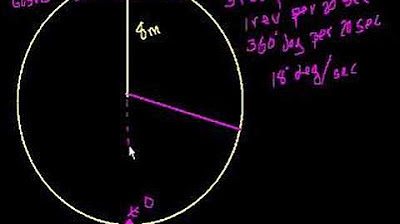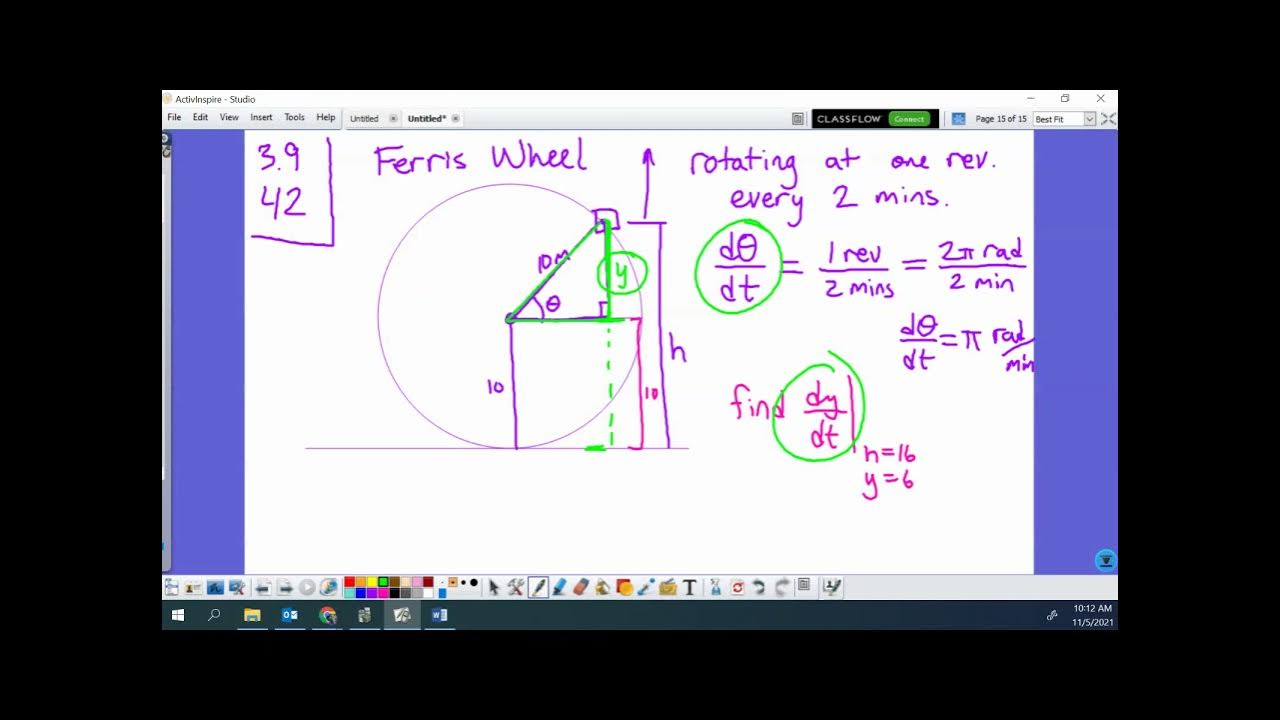Ferris Wheel Trigonometry Problem
TLDRThis video script explains the process of modeling the height of a rider on a ferris wheel over time using a cosine function. With a 30-meter diameter wheel and a center 17 meters above the ground, the ferris wheel completes one rotation every 60 seconds. The script guides through plotting points, identifying the amplitude, period, and vertical shift to derive the equation h(t) = -15cos(πt/30) + 17. It calculates the rider's height at 45 seconds and determines the times when the rider is at 15 meters high, showcasing the application of trigonometric functions in real-world scenarios.
Takeaways
- 🎡 The Ferris wheel has a diameter of 30 meters and its center is 17 meters above the ground.
- ⏱️ It completes one full rotation every 60 seconds.
- 📈 The lowest point on the Ferris wheel is 2 meters above the ground, and the highest point is 32 meters above the ground.
- 💡 The height of the Ferris wheel at different times: at 0 seconds, the height is 2 meters; at 15 seconds, it's 17 meters; at 30 seconds, it's 32 meters; at 45 seconds, it's 17 meters again; and at 60 seconds, it's back to 2 meters.
- ✏️ The cosine function models the height of the Ferris wheel over time, starting at the lowest point.
- 📐 The amplitude of the function is 15, the period is 60 seconds, and the midline is at 17 meters.
- 📝 The equation of the height function is H(t) = -15 * cos(πt/30) + 17.
- 📊 At 45 seconds, the height of the rider is 17 meters.
- 🔍 To find the times when the rider is at a height of 15 meters, solve the equation: 15 = -15 * cos(πt/30) + 17.
- 🕒 The rider reaches a height of 15 meters at approximately 13.7 seconds and 46.3 seconds.
Q & A
What is the diameter and the center height of the Ferris wheel described in the script?
-The diameter of the Ferris wheel is 30 meters, and its center is 17 meters above the ground.
What is the significance of the radius of the Ferris wheel in the context of the problem?
-The radius of the Ferris wheel, which is half of the diameter (15 meters), is used to determine the distance from any point on the circle to the center, which is essential for calculating the height of a rider at any given time.
How long does it take for the Ferris wheel to complete one rotation?
-The Ferris wheel completes one rotation every 60 seconds.
What is the lowest point on the Ferris wheel in terms of height above the ground?
-The lowest point on the Ferris wheel is 2 meters above the ground.
What is the highest point on the Ferris wheel in terms of height above the ground?
-The highest point on the Ferris wheel is 32 meters above the ground.
How is the height of the rider modeled in relation to time using the cosine function?
-The height of the rider is modeled using the cosine function in the form y = A * cos(Bx + C) + D, where A, B, C, and D are constants determined by the properties of the Ferris wheel's rotation.
What is the amplitude of the cosine function used to model the height of the rider?
-The amplitude of the cosine function is the distance from the midline to the maximum or minimum value, which is 15 meters in this case, but since the function starts at a minimum, A is -15.
How is the period of the cosine function determined in this context?
-The period of the cosine function is determined by the time it takes for the Ferris wheel to complete one rotation, which is 60 seconds. Therefore, B = 2π / (60 seconds) = π / 30.
What is the vertical shift (C) of the cosine function in the context of the Ferris wheel's height?
-The vertical shift (C) is the distance the graph is moved up or down, which corresponds to the midline of the function. In this case, C is 17 meters, the height of the center of the Ferris wheel above the ground.
What is the height of the rider at 45 seconds into the rotation?
-At 45 seconds, the rider is at a height of 17 meters, which is the same as the distance from the center of the Ferris wheel to the ground.
At what times does the rider reach a height of 15 meters during the rotation of the Ferris wheel?
-The rider reaches a height of 15 meters at approximately 13.7 seconds and 46.3 seconds into the rotation, which corresponds to two different positions on the Ferris wheel's cycle.
Outlines
🎡 Ferris Wheel Height vs. Time Graphing
This paragraph introduces the problem of graphing the height of a rider on a Ferris wheel over time using a cosine function. The Ferris wheel has a diameter of 30 meters with its center 17 meters above the ground, making one complete rotation every 60 seconds. The goal is to find the equation of the graph that models the height in relation to time, starting from the lowest point. Key points are identified at 0, 15, 30, 45, and 60 seconds, corresponding to different heights of the rider. The paragraph sets up the problem by describing the Ferris wheel's dimensions and the rotation period, preparing for the development of the cosine function equation in the next steps.
📐 Deriving the Cosine Function Equation
The paragraph focuses on deriving the equation of the cosine function that models the height of the rider on the Ferris wheel over time. It explains the process of determining the amplitude 'a', which is the radius of the Ferris wheel, and hence -15 due to the reflection across the x-axis at t=0. The period of the function is given as 60 seconds, leading to the calculation of 'b' as π/30. The vertical shift 'c' is identified as 17, the height of the center of the wheel above the ground. The final equation is formulated as h(t) = -15cos(πt/30) + 17, which gives the height of the rider at any time 't' in seconds. Additionally, the paragraph calculates the height of the rider at 45 seconds, which simplifies to 17 meters, aligning with the diagram of the Ferris wheel.
🕒 Times When Rider's Height is 15 Meters
This paragraph addresses the question of when the rider is at a height of 15 meters. It involves setting up the equation h(t) = 15 and solving for 't'. The process involves isolating the cosine function and then using the arccosine to find the angles that correspond to a height of 15 meters. Two solutions are found due to the periodic nature of the cosine function, corresponding to two different times within one rotation of the Ferris wheel. The angles are calculated using a calculator, and the times are determined by multiplying the angles by (30/π), yielding approximately 13.7 seconds and 46.3 seconds. The paragraph concludes by relating these times back to the physical Ferris wheel, explaining that these times correspond to positions just below the center of the wheel.
Mindmap
Keywords
💡Ferris Wheel
💡Diameter
💡Center
💡Rotation
💡Cosine Function
💡Amplitude
💡Midline
💡Period
💡Phase Shift
💡Arc Cosine
Highlights
The Ferris wheel has a diameter of 30 meters and the center is 17 meters above the ground.
The lowest point on the Ferris wheel is 2 meters above the ground, and the highest point is 32 meters above the ground.
The Ferris wheel completes one rotation every 60 seconds.
A rider starts at the lowest point of the Ferris wheel.
The height function of the rider is modeled using the cosine function.
The amplitude of the cosine function is determined to be 15 meters, reflecting the radius of the Ferris wheel.
The cosine function is reflected across the x-axis because the rider starts at the lowest point.
The period of the cosine function is 60 seconds, matching the rotation time of the Ferris wheel.
The value of B in the cosine function is calculated to be π/30.
The midline of the function is at y = 17, which is the vertical shift C in the cosine function.
The equation of the height function is derived as h(t) = -15cos(πt/30) + 17.
The height of the rider at 45 seconds is calculated to be 17 meters.
The rider's height of 15 meters corresponds to two specific times within the 60-second rotation.
The two times when the rider is at a height of 15 meters are approximately 13.7 seconds and 46.3 seconds.
The explanation provides a practical application of trigonometric functions to model real-world scenarios like a Ferris wheel's rotation.
The process involves understanding the properties of the cosine function and applying them to derive the equation for the Ferris wheel's height.
Transcripts
Browse More Related Video

Ferris Wheel MHF4U Modelling Trigonometric Functions Test

Ferris Wheel problem for Precalculus

Sinusoidal Function Word Problems: Ferris Wheels and Temperature

Ferris Wheel Trig Problem

3.9 #42 Related Rates Ferris Wheel Angular Velocity and Right Triangle Trig

The Ferris Wheel - Trigonometric Function Model (1 of 3: Setting up the equation)
5.0 / 5 (0 votes)
Thanks for rating: